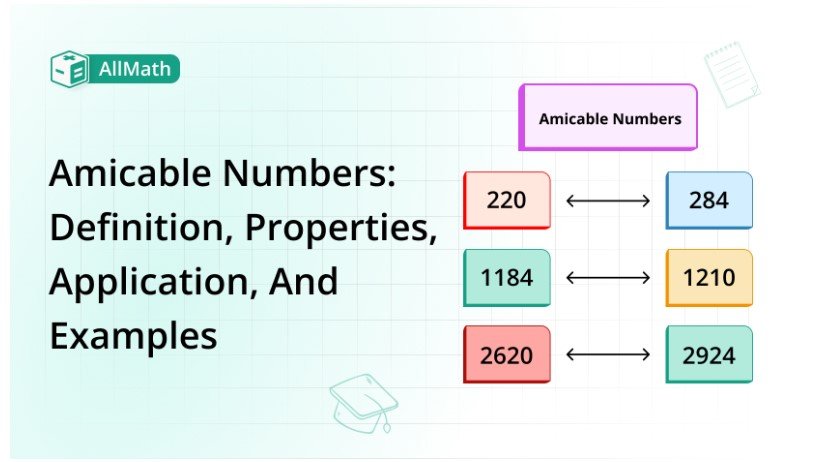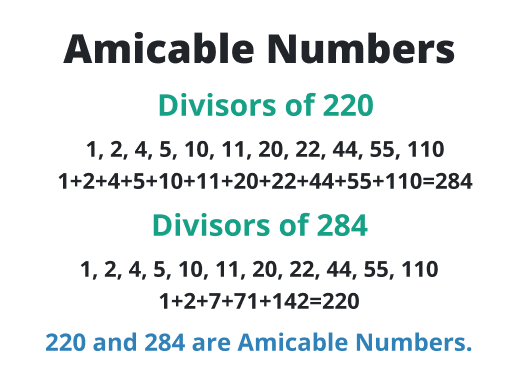To calculate result you have to disable your ad blocker first.

Amicable Numbers: Definition, Properties, Application, and Examples

Table of Content
The history of amicable numbers started in ancient times, Pythagoras and Nicomachus were the first Greek scientists who worked on these numbers. Pythagoras and his supporters were surely inspired by the magical and balanced nature of numbers.
The word “amicable” comes from the Latin word “amicus” which means friend or friendly. The idea of the amicable numbers that we know today is given by Roman mathematician Nicomachus of Gerasa (60 C.E to 120 C.E.) in his book “Introduction Arithmetica” which means an introduction to arithmetic.
Definition of Amicable Numbers
The numbers are in the form of pairs of positive integers (a, b) where the sum of the proper divisor of “a” is equal to the “b” (except the number itself) and the sum of the proper divisor of “b” is equal to “a” (except the b) are known as amicable numbers.

These numbers are also known as balanced numbers because they have a balanced relationship between them.
Representation of Amicable Numbers
Generally, we can represent the amicable numbers in the form of pairs (a, b). let, σ (a) be the sum of the proper divisor of positive integer “b” and σ (b) be the sum of the proper divisor of a positive integer “a” then we can say,
σ (a) = b
σ (b) = a
This relationship makes an amicable number and we also can say that it is a balanced pair or friendly pair.
Properties of Amicable Numbers
Some properties of amicable numbers are as follows:
- Mutual Sum of divisors
The most basic property of the amicable number is that the sum of all proper divisor positive integers of a number in a pair contributes to the other number in the pair.
- Abundance and Deficiency
Amicable numbers are generally linked with the idea of abundance and deficiency. If the sum of the proper divisors of the positive integer is less than the number, then it is known as the deficient number. And, if the sum of the proper divisors of the positive integer is greater than the number, then it is known as an abundant number.
- Unique appearance
If we compare the amicable numbers with the total set of positive integers, we know these numbers are relatively rare.
- Factorization
Amicable numbers generally contribute common prime factors. This property comes from the matter that the sum of the divisors is affected by the prime factorization of a number.
Applications of Amicable Numbers
Some applications of amicable numbers are as follows:
- Mathematical skills advancement
- Boost up computational abilities
- Number system recognition
- Enhance cryptography understanding
- Establish algorithmic thinking
- Increase mathematical modeling
- Enlarge problem-solving ability and critical thinking
Mathematical skills advancement
Amicable numbers are used to advance your skills in mathematics. By studying these numbers, you would be able to think logically and you can sort out most of the mathematical problems.
Boost up computational abilities
These numbers are also used to boost the computational skills of the learner. The computational abilities help the learner in effectively using mathematical tools like MATLAB software etc.
Number system recognition
These numbers are also helpful in understanding the whole structure of the number system. It tells us how it works and how can we easily use it. It makes it easier to understand the number pattern.
Enhance cryptography understanding
Amicable numbers also help you to advance your knowledge about cryptography. Understanding cryptography depends on understanding number theory, which makes secure communication and encryption.
Establish algorithmic thinking
These numbers help the learner establish his thinking according to an algorithm. They can solve their problem in a simple manner by using the technique of an algorithm in which the problem is solved by using a step-by-step procedure.
Increase mathematical modeling
These numbers help you to learn a lot about mathematical modeling and also enhance your skills in mathematical modeling. The technique to represent the real-world problem in the mathematical formulation is known as mathematical modeling.
Enlarge problem-solving ability and critical thinking
These numbers help you think critically and enhance your ability to solve a problem. These numbers advance your coding skills.
Examples of Amicable Numbers
Some examples of amicable numbers are as follows:
Example 1:
Check whether this pair is amicable or not.
(220, 284)
Solution:
Step 1: make the proper divisors of 220.
1, 2, 4, 5, 10, 11, 20, 22, 44, 55, and 110
Step 2: By making the proper divisors of 284.
1, 2, 4, 71, and 142
Step 3: Calculate the sum of the proper divisor of 220.
Sum (220) = 284
Step 4: sum up the proper divisor of 284.
Sum (284) = 220
So, it is clearly seen that the above-mentioned pair is an amicable pair.
Example 2:
Check whether is this an amicable pair or not.
(2620, 2924)
Solution:
Step 1: make the proper divisors of 2620.
1, 2, 4, 5, 10, 20, 131, 262, 524, 655, and 1310
Step 2: By making the proper divisors of 2924.
1, 2, 4, 17, 34, 68, 43, 86, 172, 731, and 1462
Step 3: Calculate the sum of the proper divisor of 2620.
Sum (2620) = 2924
Step 3: Calculate the sum of the proper divisor of 2924.
Sum (2924) = 2620
So, it is clearly seen that the above-mentioned pair is an amicable pair.
The following table shows a collection of amicable numbers.
Amicable pair | 1st number | 2nd number |
1 | 2620 | 2924 |
2 | 6232 | 6368 |
3 | 12285 | 14595 |
4 | 67095 | 71145 |
5 | 79750 | 88730 |
6 | 122265 | 139815 |
7 | 122368 | 123152 |
Wrap up
In this article, we determined the amicable numbers, the history of these numbers, the definition, properties, applications, and examples. These numbers are very helpful in different fields. These numbers didn’t have a direct link with any field but these numbers are linked indirectly.
These numbers have a great influence on the science and IT fields. We discussed the concept of amicable numbers in a very simple way so that everyone can easily understand the whole concept of these numbers through a complete overview of this article.
